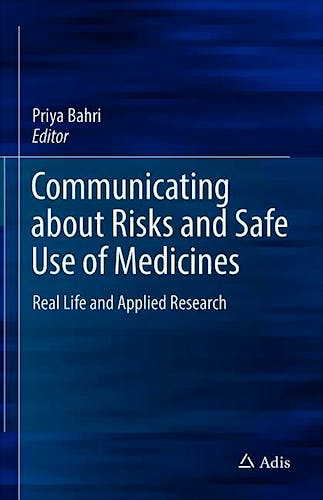

No hay productos en el carrito



Communicating about Risks and Safe Use of Medicines. Real Life and Applied Research
Bahri, P.
1ª Edición Junio 2020
Inglés
Tapa dura
530 pags
1000 gr
16 x 24 x 3 cm
ISBN 9789811530128
Editorial ADIS
LIBRO IMPRESO
-5%
114,39 €108,67 €IVA incluido
109,99 €104,49 €IVA no incluido
Recíbelo en un plazo de
2 - 3 semanas
LIBRO ELECTRÓNICO
-5%
103,99 €98,79 €IVA incluido
99,99 €94,99 €IVA no incluido
Acceso On Line
Inmediato
Foreword Baruch Fischhoff
Preface: Guide for readers Priya Bahri
Authors' biographical notes
Overview of contents in chapters
1. A multilayered research framework for humanities and epidemiology of medicinal product risk communication Priya Bahri
Part I: Medicines in real life as communication challenges
2. Hormonal contraceptives - Communication for risk awareness and informed choice, or a public scare? Barbara Mintzes, Teresa Alves, with a contribution from Priya Bahri
3. COX-2 inhibitors - Communication of accumulating risk evidence and a product withdrawalAmy Rogers, Kerr Grieve, Thomas M MacDonald, with a contribution from Sergio Nishioka
4. Isotretinoin - Communication for preventing birth defects and alerting of an uncertain risk of suicideIneke (HJMJ) Crijns
5. Pandemic influenza vaccines - Communication of benefits, risks and uncertaintiesGlen J Nowak, Emilie Karafillakis, Heidi Larson
Part II: Tackling the challenges - Methods for medicinal product risk communication research
6. Ethical frameworksGhislaine van Thiel
7. The cognitive and behavioural sciencesSara Rubinelli, Nicola Diviani, Maddalena Fiordelli
8. The social sciencesBrian Taylor, Anne Moorhead
9. Rhetoric and science & technology studiesMathias Mollebaek
10. Media science and practiceGlen J Nowak, Michael A Cacciatore
11. Social media researchNabarun Dasgupta, Carly Winokur, Carrie E Pierce
12. Design science with a focus on user-centred evaluation of written informationJoerg Fuchs
13. Dissemination & implementation scienceElaine Morrato, Meredith Smith
14. PharmacoepidemiologyBert (HGM) Leufkens
15. Legal frameworksBurkhard Strater
16. From passive to active - Patients as contributors to medicinal product risk communication researchFrancois Houyez
Afterword: The dimension of communicating medicine risks in low- and middle-income countriesNilima A Kshirsagar
At the core of this book lies the question how to approach medicines, risks and communication as a researcher - or anybody planning and evaluating a communication intervention, or wanting to understand communication events in private and the media. With a view to tackle current shortcomings of communication systems and processes for improved implementation, patient satisfaction and health outcomes, a multilayered approach is presented. This combines multiple data types and methods to obtain a wider and deeper understanding of the major parties and their interactions, as well as the healthcare, social and political contexts of information flows, how they interfere and which impact they have. Illustrated with real life experiences of safety concerns with medicines, worldwide active experts discuss the methods and contributions their disciplines can offer. With considerations on terminologies, tabulated overviews on communication types and outcomes, a patient-centred vision and plain language for non-medical readers, the book creates a platform for multidisciplinary collaborations amongst researchers as well as practitioners from communications, healthcare, the social sciences and pharmacovigilance. Importantly, it advocates for an active role of patients and highlights the achievements and aspirations of patient organisations. Finally, the book suggests establishing an inclusive discipline of humanities and epidemiology of medicinal product risk communication to realise full research potential. The authors are driven by the curiosity for communication as the most human behaviour, and as good health is amongst the basic human needs, medicinal product risk communication is an exciting research field of high global relevance.
Priya Bahri holds degrees in pharmacy and epidemiology, her PhD dealt with quality management in healthcare, and she has training in strategic health communication and global health diplomacy. She worked in pharmacies and the German international development agency before joining the European Medicines Agency (EMA) in 1996 and specialising in pharmacovigilance. She offers contributions to the Utrecht WHO Collaborating Centre for Pharmaceutical Policy and Regulation and is active at global level, including as Fellow of the International Society of Pharmacovigilance.
© 2025 Axón Librería S.L.
2.149.0